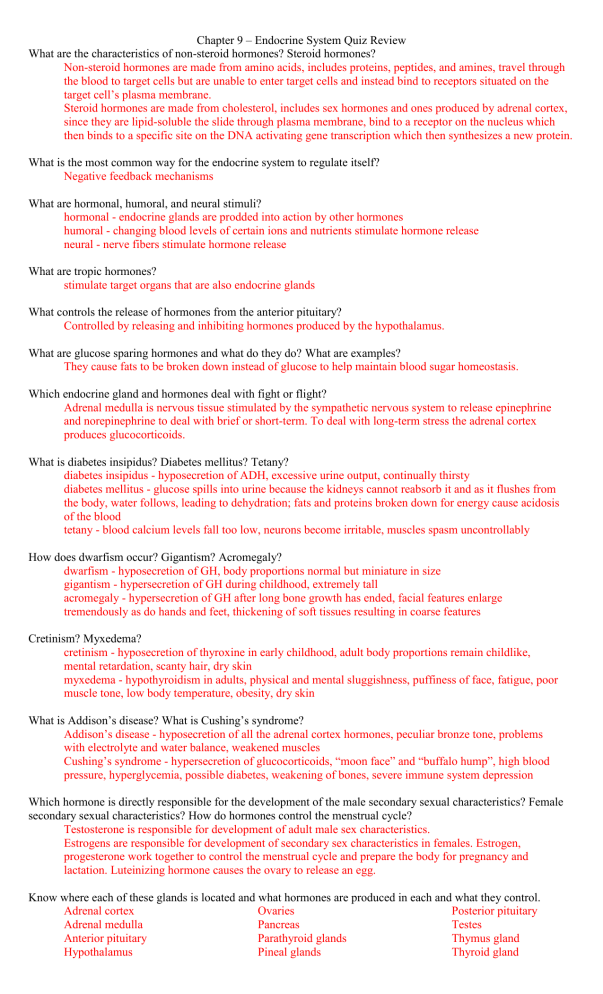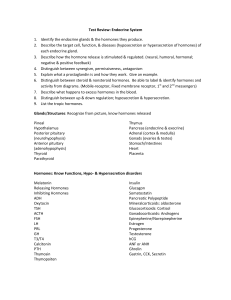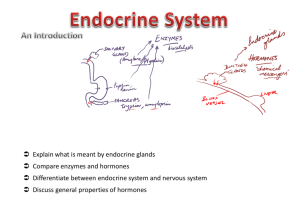Chapter 9 – Endocrine System Quiz Review What are the

Chapter 9 – Endocrine System Quiz Review
What are the characteristics of non-steroid hormones? Steroid hormones?
Non-steroid hormones are made from amino acids, includes proteins, peptides, and amines, travel through the blood to target cells but are unable to enter target cells and instead bind to receptors situated on the target cell’s plasma membrane.
Steroid hormones are made from cholesterol, includes sex hormones and ones produced by adrenal cortex, since they are lipid-soluble the slide through plasma membrane, bind to a receptor on the nucleus which then binds to a specific site on the DNA activating gene transcription which then synthesizes a new protein.
What is the most common way for the endocrine system to regulate itself?
Negative feedback mechanisms
What are hormonal, humoral, and neural stimuli? hormonal - endocrine glands are prodded into action by other hormones humoral - changing blood levels of certain ions and nutrients stimulate hormone release neural - nerve fibers stimulate hormone release
What are tropic hormones? stimulate target organs that are also endocrine glands
What controls the release of hormones from the anterior pituitary?
Controlled by releasing and inhibiting hormones produced by the hypothalamus.
What are glucose sparing hormones and what do they do? What are examples?
They cause fats to be broken down instead of glucose to help maintain blood sugar homeostasis.
Which endocrine gland and hormones deal with fight or flight?
Adrenal medulla is nervous tissue stimulated by the sympathetic nervous system to release epinephrine and norepinephrine to deal with brief or short-term. To deal with long-term stress the adrenal cortex produces glucocorticoids.
What is diabetes insipidus? Diabetes mellitus? Tetany? diabetes insipidus - hyposecretion of ADH, excessive urine output, continually thirsty diabetes mellitus - glucose spills into urine because the kidneys cannot reabsorb it and as it flushes from the body, water follows, leading to dehydration; fats and proteins broken down for energy cause acidosis of the blood tetany - blood calcium levels fall too low, neurons become irritable, muscles spasm uncontrollably
How does dwarfism occur? Gigantism? Acromegaly? dwarfism - hyposecretion of GH, body proportions normal but miniature in size gigantism - hypersecretion of GH during childhood, extremely tall acromegaly - hypersecretion of GH after long bone growth has ended, facial features enlarge tremendously as do hands and feet, thickening of soft tissues resulting in coarse features
Cretinism? Myxedema? cretinism - hyposecretion of thyroxine in early childhood, adult body proportions remain childlike, mental retardation, scanty hair, dry skin myxedema - hypothyroidism in adults, physical and mental sluggishness, puffiness of face, fatigue, poor muscle tone, low body temperature, obesity, dry skin
What is Addison’s disease? What is Cushing’s syndrome?
Addison’s disease - hyposecretion of all the adrenal cortex hormones, peculiar bronze tone, problems with electrolyte and water balance, weakened muscles
Cushing’s syndrome - hypersecretion of glucocorticoids, “moon face” and “buffalo hump”, high blood pressure, hyperglycemia, possible diabetes, weakening of bones, severe immune system depression
Which hormone is directly responsible for the development of the male secondary sexual characteristics? Female secondary sexual characteristics? How do hormones control the menstrual cycle?
Testosterone is responsible for development of adult male sex characteristics.
Estrogens are responsible for development of secondary sex characteristics in females. Estrogen, progesterone work together to control the menstrual cycle and prepare the body for pregnancy and lactation. Luteinizing hormone causes the ovary to release an egg.
Know where each of these glands is located and what hormones are produced in each and what they control.
Adrenal cortex Ovaries Posterior pituitary
Adrenal medulla
Anterior pituitary
Pancreas
Parathyroid glands
Testes
Thymus gland
Hypothalamus Pineal glands Thyroid gland
Chapter 9 – Endocrine System Quiz Review
What are the characteristics of non-steroid hormones? Steroid hormones?
Non-steroid hormones are made from amino acids, includes proteins, peptides, and amines, travel through the blood to target cells but are unable to enter target cells and instead bind to receptors situated on the target cell’s plasma membrane.
Steroid hormones are made from cholesterol, includes sex hormones and ones produced by adrenal cortex, since they are lipid-soluble the slide through plasma membrane, bind to a receptor on the nucleus which then binds to a specific site on the DNA activating gene transcription which then synthesizes a new protein.
What is the most common way for the endocrine system to regulate itself?
Negative feedback mechanisms
What are hormonal, humoral, and neural stimuli? hormonal - endocrine glands are prodded into action by other hormones humoral - changing blood levels of certain ions and nutrients stimulate hormone release neural - nerve fibers stimulate hormone release
What are tropic hormones? stimulate target organs that are also endocrine glands
What controls the release of hormones from the anterior pituitary?
Controlled by releasing and inhibiting hormones produced by the hypothalamus.
What are glucose sparing hormones and what do they do? What are examples?
They cause fats to be broken down instead of glucose to help maintain blood sugar homeostasis.
Which endocrine gland and hormones deal with fight or flight?
Adrenal medulla is nervous tissue stimulated by the sympathetic nervous system to release epinephrine and norepinephrine to deal with brief or short-term. To deal with long-term stress the adrenal cortex produces glucocorticoids.
What is diabetes insipidus? Diabetes mellitus? Tetany? diabetes insipidus - hyposecretion of ADH, excessive urine output, continually thirsty diabetes mellitus - glucose spills into urine because the kidneys cannot reabsorb it and as it flushes from the body, water follows, leading to dehydration; fats and proteins broken down for energy cause acidosis of the blood tetany - blood calcium levels fall too low, neurons become irritable, muscles spasm uncontrollably
How does dwarfism occur? Gigantism? Acromegaly? dwarfism - hyposecretion of GH, body proportions normal but miniature in size gigantism - hypersecretion of GH during childhood, extremely tall acromegaly - hypersecretion of GH after long bone growth has ended, facial features enlarge tremendously as do hands and feet, thickening of soft tissues resulting in coarse features
Cretinism? Myxedema? cretinism - hyposecretion of thyroxine in early childhood, adult body proportions remain childlike, mental retardation, scanty hair, dry skin myxedema - hypothyroidism in adults, physical and mental sluggishness, puffiness of face, fatigue, poor muscle tone, low body temperature, obesity, dry skin
What is Addison’s disease? What is Cushing’s syndrome?
Addison’s disease - hyposecretion of all the adrenal cortex hormones, peculiar bronze tone, problems with electrolyte and water balance, weakened muscles
Cushing’s syndrome - hypersecretion of glucocorticoids, “moon face” and “buffalo hump”, high blood pressure, hyperglycemia, possible diabetes, weakening of bones, severe immune system depression
Which hormone is directly responsible for the development of the male secondary sexual characteristics? Female secondary sexual characteristics? How do hormones control the menstrual cycle?
Testosterone is responsible for development of adult male sex characteristics.
Estrogens are responsible for development of secondary sex characteristics in females. Estrogen, progesterone work together to control the menstrual cycle and prepare the body for pregnancy and lactation. Luteinizing hormone causes the ovary to release an egg.
Know where each of these glands is located and what hormones are produced in each and what they control.
Adrenal cortex Ovaries Posterior pituitary
Adrenal medulla
Anterior pituitary
Hypothalamus
Pancreas
Parathyroid glands
Pineal glands
Testes
Thymus gland
Thyroid gland








